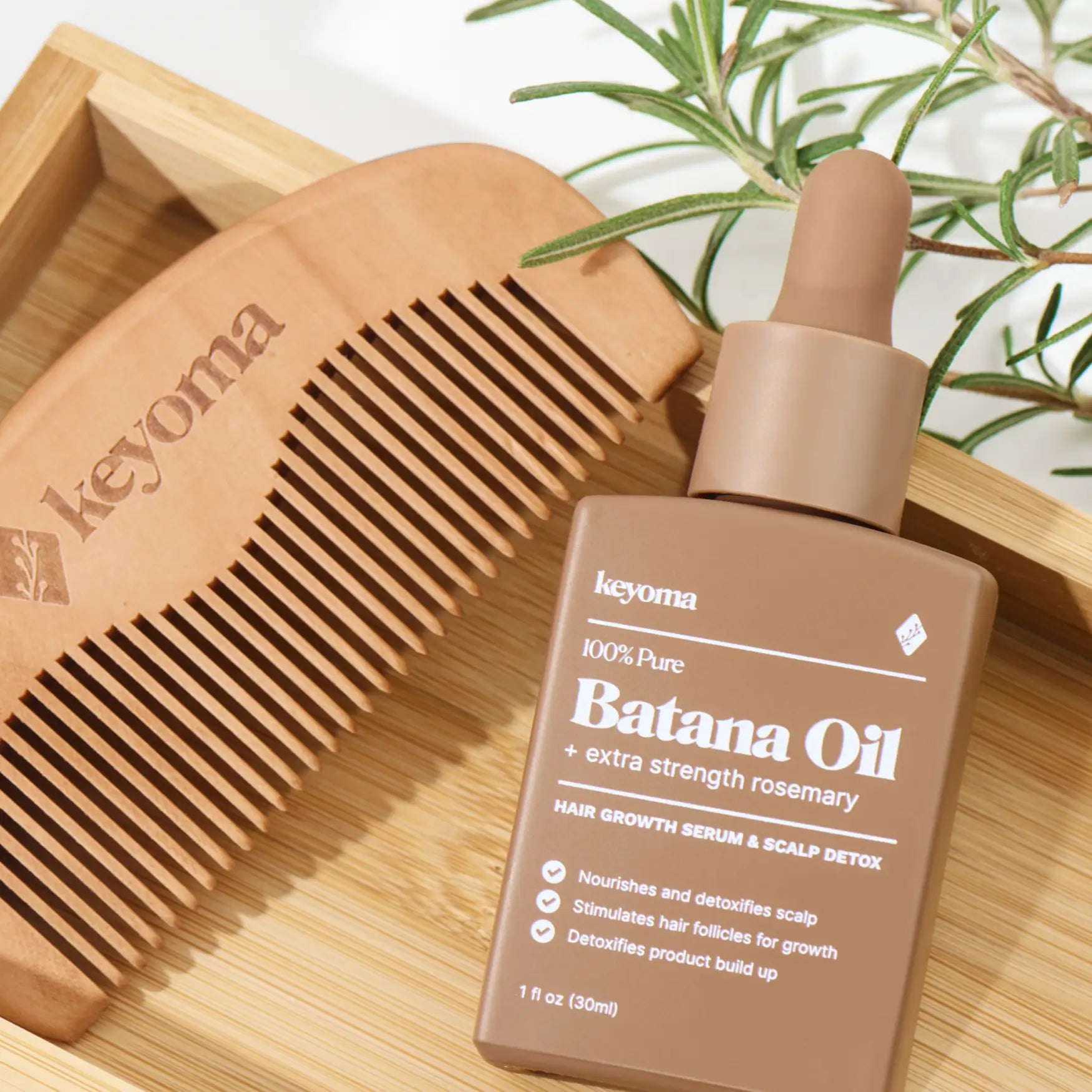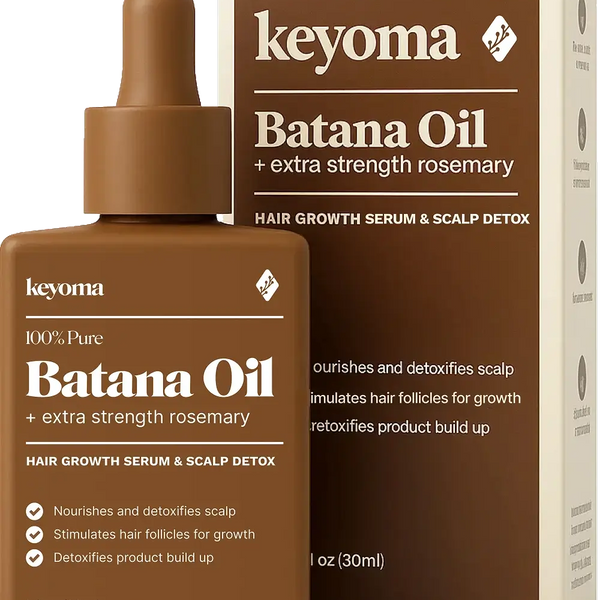In this article
Many people swear by dry shampoo. It's the modern girl's secret weapon for fixing greasy roots and buying an extra day before wash day, perfect for busy mornings, last-minute plans, and post-gym sessions.
But while it feels like magic in a bottle, there’s a fine line between smart use and overuse. Too much of it, or using it the wrong way, can quietly throw your scalp off balance and cause more problems than it solves.
In this guide, we’ll unpack how dry shampoo really works, when it’s safest to use, and the right way to make it part of your routine without compromising scalp or hair health.
How Does Dry Shampoo Work?
Dry shampoo is a spray or powder product that works by absorbing excess oil, sweat, and odor from your scalp, giving your hair a fresher look and feel without washing it with water, all in just a few minutes.
The science behind it is pretty straightforward. The base ingredients (usually starches or clays) act like miniature sponges. When sprayed or sprinkled onto the roots, they "soak up" sebum (your scalp's natural oil) and other residues sitting on the surface, almost like you've just washed your hair.
When applied correctly, dry shampoo offers several short-term benefits:
-
Extends time between washes by soaking up grease and reviving limp roots.
-
Adds volume at the crown, especially useful for flat, day-two or day-three hair.
-
Refreshes hair post-workout or during travel when regular shampooing isn’t possible.
-
Preserves hair color in dyed hair by reducing exposure to frequent washing.
Does Dry Shampoo Actually Clean Your Hair?
Despite the oil absorption, volume boost, and quick refresh it offers, dry shampoo doesn’t clean your hair in the way regular washing with water and shampoo does.
What it does is soak up excess oil and mask odors on the surface temporarily. It doesn’t remove grime, sweat, or product residue that builds up on the scalp.
For that reason, both dermatologists and hair stylists recommend using it only as a quick fix and not a full-time replacement for actual shampooing and scalp cleansing.
When Should I Use Dry Shampoo?
You should use dry shampoo in between regular wash days. And the best times to do it are during:
-
Post-workout or sweat: Absorbs scalp moisture and odor when you don’t have time to rinse right away.
-
Early mornings or late nights: Saves you the hassle of a full shower when you’re pressed for time.
-
Travel or camping: Keeps you feeling clean when access to showers is limited. In fact, I’ve previously talked about how dry shampoo can be a travel hair care essential for staying fresh on the go.
-
After styling or blowouts: Extends the life of your blow-dry or heat style by preventing oil from weighing your hair down.
Different Types of Dry Shampoo
Now, why are there even different types of dry shampoo?
It all comes down to hair needs, lifestyle habits, and even scalp sensitivity. Some people want a quick fix without touching their hair, while others need better ingredient control, zero residue, or something that won’t disturb their curls or color.
Below’s a closer look at each of the four main types.
Aerosol or Mist Dry Shampoo
Aerosol sprays are the most common and widely used format. Powered by propellants like butane or isobutane, they deliver a fine mist that quickly absorbs oil at the roots without needing to touch the hair.
They're best for those with straight or wavy hair looking for volume or a fast refresh. But because they may contain fragrance and alcohol, those with sensitive scalps or fragrance concerns should check labels carefully.
Powder Dry Shampoo
Powder-based dry shampoos usually come in shaker bottles or jars and are applied directly onto the scalp using your fingers or a brush. These formulas typically use starches like rice starch or clays like kaolin to absorb oil and odor.
Powders are ideal for fine, curly, or textured hair types since they’re free of drying alcohol and give more control over placement.
Some are also tinted to match darker hair tones and avoid the white cast common with traditional powders.
Gel Dry Shampoo
This newer format goes on like a clear gel and evaporates within seconds. It doesn’t foam or lather but uses fast-drying alcohols and absorbing agents like silica to soak up oil.
It’s a great option for those who hate the mess of powders or sprays, especially in short styles or bangs. Just apply with your fingertips, wait for it to dry down, and style as usual.
Foam Dry Shampoo
Foam versions are lightweight and applied by hand. Unlike gels, these start as a mousse and settle into the scalp without needing a brush. They’re ideal for curly or dry hair types that need to revive shape and absorb oil while keeping moisture intact.
Some also include hydrating agents to prevent frizz, making them a better fit for naturally dry textures or winter routines
How to Use Dry Shampoo Properly

Using dry shampoo isn’t just a matter of spraying and going. To get the best results (without irritating your scalp or dulling your hair), here’s how to use it the right way:
Step 1: Start With Dry Hair Only
Dry shampoo won’t work on wet or damp hair. In fact, applying it to wet hair will cause the powder or mist to clump and become ineffective. Always wait until your hair is completely dry before using any dry shampoo.
Step 2: Shake, Section, and Apply to Roots
Whether you're using an aerosol, powder, foam, or gel dry shampoo, always start by shaking the container or tube well. This redistributes the starches or clays like rice starch or kaolin clay so they don’t settle unevenly.
Then section off 1–2 inch areas of dry hair and apply the product directly to the scalp:
-
For aerosols or mists, hold the can 6 inches away and spray short bursts at the roots.
-
For powders, sprinkle or tap the product gently using your fingertips or a brush.
-
For foams, pump a small amount into your hands and dab it into the scalp with your fingers.
-
For gels, squeeze a pea-sized amount, spread it between your palms, and work it into oily areas.
Focus on high-sebum zones like the crown, hairline, and nape, and always avoid applying too close to the scalp in one spot to prevent buildup or patchiness.
Step 3: Let it Sit (and Don’t Touch It Yet)
Let the product sit undisturbed for about 30 seconds to 2 minutes. This step is essential as the starches need time to absorb the oil before you start massaging or brushing. The longer it sits (within reason), the better it works.
Step 4: Massage or Brush it Out
Use your fingertips to gently massage the product into your scalp. Then use a boar bristle or soft paddle brush to distribute any remaining powder and remove excess residue. This gives a clean look and avoids white patches.
Step 5: Style and finish
If you’re heat styling, apply dry shampoo before using a blow dryer or flat iron, not after. The product can act as a barrier, and heat can help activate volume without cooking it into the hair.
Step 6: Don’t Wash Immediately After
You don’t need to wash your hair right after using dry shampoo. In fact, the whole point is to extend your style or buy time between washes. Only plan to wash once your scalp starts to feel clogged, itchy, or visibly flaky, or when your next wash day is due.
Is It Safe to Use Dry Shampoo Every Day?
As hassle-free and time-saving as dry shampoo is, using it every single day isn’t safe. Overuse can lead to scalp buildup, clogged follicles, and irritation, all of which can eventually cause more serious scalp issues down the line
According to dermatologists from the American Academy of Dermatology (AAD), it’s best to wash your hair after one or two uses of dry shampoo.
Dry Shampoo Side Effects (When Misused)
Scalp Buildup and Follicle Blockage
When left unwashed for days, starches, clays, and styling residue can build up on your scalp. This buildup clogs hair follicles, traps sebum and bacteria, and interrupts the natural oil flow your scalp needs to stay balanced.
That’s when irritation, itchiness, and flaking start to show up, even if you don’t normally have dandruff.
Seborrheic Dermatitis
Dry shampoo overuse can throw off the natural oil balance of your scalp, which, when paired with product buildup, paves the perfect path for conditions like seborrheic dermatitis to flare up.
This common scalp disorder is tied to excess sebum and yeast overgrowth, both of which are made worse when you skip real washing for too long.
Worsening of Pre-Existing Scalp Conditions
If you already have eczema, psoriasis, or even mild scalp acne, layering dry shampoo without a proper cleanse can make it worse. The absorbing agents might seem harmless, but in closed or inflamed skin, they can trap irritants closer to the surface and aggravate flare-ups.
Oily Scalp and Hair
As ironic as it sounds, the more you rely on dry shampoo, the more your scalp may start overproducing oil. This rebound effect happens when your scalp thinks it's too dry and tries to correct it.
That leaves you stuck in a loop of needing dry shampoo more often, while making your scalp even oilier underneath.
Can I Make a DIY Dry Shampoo at Home?
Yes, you can make a DIY dry shampoo at home. In fact, many of the basic ingredients used in commercial formulas (like rice starch, cornstarch, kaolin clay, or even arrowroot powder) are easy to find in your pantry or local health store.
Some trending blends even include cocoa powder for brunettes or activated charcoal for added detox properties.
BUT, is it advisable?
Dermatologists from the American Academy of Dermatology caution against DIY dry shampoo formulas.
The main issue with homemade dry shampoo is how inconsistent and clumpy it can be. Without the fine processing or blending technology that commercial brands use, DIY powders are more likely to sit visibly on the scalp, clump unevenly, and even clog follicles more easily.
Dry Shampoo vs Regular Shampoo
The key difference between dry shampoo and regular shampoo lies in their primary function: Dry shampoo absorbs surface oil and refreshes your hair’s appearance temporarily, while regular shampoo deeply cleanses the scalp, removing sweat, sebum, dead skin cells, and product buildup.
In other words, dry shampoo leans more to the identity of being a styling product, while regular shampoo is an essential scalp care product. So, you really shouldn’t confuse one for the other.
Here’s how they compare in other areas:
-
Use case: Dry shampoo is used between washes to extend time between rinses. Regular shampoo is used during wash days to reset the scalp.
-
Ease of Use & Time: Dry shampoo is quick and mess-free—no water, no towel-drying, no wait time. Regular shampoo takes more effort and time but provides a full cleanse.
-
Finish & Feel: Dry shampoo gives instant lift, matte texture, and volume, whereas regular shampoo gives softness, smoothness, and that “clean slip.”
Can I Use Hair Oils With Dry Shampoo?
Yes, you can use hair oils with dry shampoo, but it has to be done the right way: apply dry shampoo to the roots first, then use hair oil from the mid-lengths to the ends.
Before applying any oil, brush your hair and scalp thoroughly to remove leftover dry shampoo particles. This ensures you’re not layering oil over a film of starch or clay, which can feel gritty and weigh your hair down.
Great options for mid-to-end nourishment include lightweight oils like argan, jojoba, grapeseed, or batana oil blends.
And just to be clear, never apply both oil and dry shampoo directly to your scalp. Doing so only creates a sticky, unwashed feeling and the kind of buildup that defeats the purpose of using either product.
Frequently Asked Questions (FAQs)
Is dry shampoo recommended by dermatologists?
Yes, as long as you don’t overdo it. The American Academy of Dermatology recommends using dry shampoo occasionally and not as a substitute for regular shampooing. It’s meant to stretch time between washes, not replace them altogether.
Do you use dry shampoo before or after a shower?
Neither, because the whole point of dry shampoos is to use them on non-wash days. During these periods when you're not washing your hair, dry shampoos can absorb excess oil and freshen up your scalp.
Can you leave dry shampoo in overnight?
Yes, but with a few conditions. If you apply it before bed, make sure to brush it out well in the morning. Leaving it too long without brushing can lead to buildup, especially if you reapply the next day without washing in between.
Use Dry Shampoo Wisely and Pair It Right
Dry shampoo makes hair care easier on non-wash days, keeping grease in check and saving you time when life gets busy. But remember: it’s not a cleanser, and using it too often without a proper shampoo routine can lead to more harm than good.
That’s why it should be treated as just one part of a well-rounded hair and scalp routine. You’ve got proper cleansing with water and real shampoo, regular scalp exfoliation, and moisturizing with nourishing hair oils like batana, jojoba, or grapeseed to keep the lengths soft and healthy.
Head over to the Keyoma Blog for more hair science, real-life routines, and product tips that meet your hair where it’s at!
Featured Product
100% Pure Batana Oil + Rosemary









